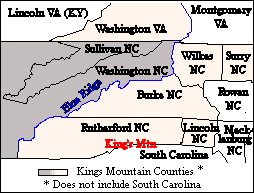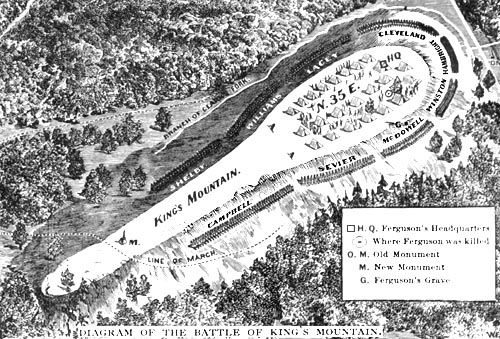
|
The Battle of
King's Mountain 7 Oct 1780 |
Did you know that nearly half the men who fought at the Battle of King's Mountain were Tennessee “Overmountain Men?” That the Battle of King's Mountain is credited with having turned the tide of the Revolution? That without King's Mountain, America might have had only ten colonies? That the battle was not Americans against the British, but Americans against Americans? That the American Whigs bested the American Tories in only one hour, took over 800 prisoners and then proceded to “lose” them? Or that hundreds of Whigs “deserted” right along with the hundreds of Tories they “lost?”

|
by C. Hammett, Coordinator Tennesseans in the Revolutionary War
King's Mountain is unique in America's history: This battle—fought by 1,000 plus militiamen—without orders, formal military training, uniforms or provisions, and with no promise of pay—against the supposedly “superior forces” (1) of noted English Col. Patrick Ferguson—is credited by most early historians with having changed the course of the Revolution in the South, and may have even insured that the original number of colonies in these United States of America would be thirteen, not ten. (2)
In only one hour and five minutes, the American Whigs (Patriots, Rebels) totally decimated Ferguson's American Tories (Loyalists, Royalists), with every last man of them either dead or taken prisoner, and the Colonel himself left dead on the battlefield—having signed his own death warrant less than a month earlier when he sent a message from his camp in Gilbert Town, Rutherford County, North Carolina, to the “officers on the Western waters” (west of the Blue Ridge) that if they did not “desist from their opposition to the British army, and take protection under his standard, he would march his army over the mountains, hang their leaders, and lay their country waste with fire and sword.” (3) Col. Ferguson's warning was the result of his frustration over the refusal of most of the Overmountain men (east Tennessean and southwestern Virginians) to take the loyalty oath and to cease providing safe harbours for militiamen from the Carolinas and Georgia (who had eluded him after the August 16th defeat of American General Gates and the American army at the battle of Camden by retreating ”overmountain” to the “western waters”). It did not have the expected results: The message was delivered to Sullivan County, North Carolina (now Tennessee) Militia Colonel Isaac Shelby of Sapling Grove (present-day Bristol, Sullivan County, Tennessee), who immediately rode out to confer with neighboring Washington County, North Carolina (now Tennessee) Militia Colonel John Sevier. The two men agreed that the best solution was to "march with all the men we could raise, and attempt to surprise Ferguson, by attacking him in his camp, or at any rate before he was prepared..." (4) Col. Shelby also convinced Col. William Campbell, commander of the county militia in neighboring Washington County, Virginia, to join him and Sevier on 25 Sep 1780 at Watauga, the time and place they had appointed for their rendevous. Also "overmountain" at the time were Cols. Charles McDowell and Andrew Hampton and their militiamen (from Burke and Rutherford Counties, North Carolina, respectively), and when the five county militias assembled on the 25th, they were over 1,000 strong. The following day they began their march across the mountains, and on September 30th met up with Cols. Benjamin Cleveland and Joseph Winston and their 350 militiamen from Wilkes and Surry Counties, North Carolina (respectively), bringing their total to almost 1,400. (5) The seven officers were well aware that they and their men were "amateurs" on a regular field of battle (although the Overmountain men were well-experienced in Indian-fighting), and also that they did not have the proper authority to take the action they contemplated. On October 4th, they dispatched by Col. McDowell (who left his brother, Joseph, in charge of his troops) a Request to General Gates for a general officer to command them, but in the meantime elected Col. Campbell temporary commander, and continued to march toward Gilbert Town. (ibid.) 
Created from Goldbug's AniMap
The next day they learned that Ferguson had been apprised of their approach, and had left Gilbert Town. The council of officers met that night and determined to pursue him no matter to what ends. Leaving behind their footsoldiers and weaker horses to catch up when they could, the men continued forward, and on the 6th of September, at Cowpens, South Carolina, were joined by Col. James Williams of Granville County, North Carolina, who was accompanied by about 400 men (largely from Sumter's South Carolina troops under Colonels Hill, Lacey and Graham), but also including 60 militiamen from Lincoln County, North Carolina under Col. Andrew Hambright, and another 60 South Carolina militiamen under Major William Chronicle. Colonel Williams, also in pursuit of Ferguson, was able to advise them of Ferguson's location: He was atop King's Mountain. (ibid.)
After an all-night forced march in pouring rains, at three o'clock the afternoon of the following day, on the 7th of October, the men circled the mountain and charged. 
Created from Draper illustration, p. 237
Only one hour later, Ferguson and scores of his troops were dead, and the remainder, many wounded, taken prisoner. The rest is history...
The details of the battle, as well as events both preceding and following it, are recounted in a number of sources, some of which are published here, including several unique perspectives:
END NOTES 1 The "superiority" of Col. Ferguson's troops has been somewhat exaggerated: While Col. Ferguson himself was a highly-trained and experienced officer, the vast majority of his men, all but a handful, were Americans, either militiamen or "Provincials" (American Loyalists), as is documented by both American and British records. Likewise, while both sides initially believed they were heavily outnumbered by the other, they were in fact, fairly equal (if anything, the Whigs probably outnumbered the Tories). (King's Mountain: History Revisited) 2 Only two Major battles had been fought in the South in 1780, Charleston and Camden, and the Whigs had been defeated at both. These defeats had been followed by unsubstantiated reports that England would agree to a division under which North and South Carolina (including present-day Tennessee) and Georgia would remain British. (Historical Statement Concerning the Battle of King's Mountain, Part III). 3 "Battle of King's Mountain" by Isaac Shelby, a pamphlet "to the public," published in April 1823, and reprinted in King's Mountain and Its Heroes: History of the Battle of King's Mountain, October 7th, 1780, and the Events Which Led to It by Lyman C. Draper, Cincinnati, 1881, pp. 560-573. 4 ibid., p. 562 5 ibid., p. 563-565, and Formal Report of the Colonels. The figures from both these sources have long been disputed by various historians, both American and English, but it is generally accepted by most that the number of American Patriots (a.k.a. Rebels, Whigs) at the battle was between 1,000 and 1,200, and the number of American Loyalists (Tories) between 800 and 1,100. |

Researchers: If your ancestor fought at King's Mountain, whether Whig or Tory, American or Englishman, please submit his name and supporting documentation by posting to the Tennesseans of the Revolution Records Board and it will be added to our site, The Men of King's Mountain.
Return to
Tennesseans in the Revolutionary War
The TNGenWeb Project

©2000 - present, TNGenNet, Inc.